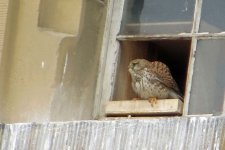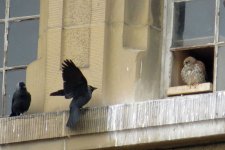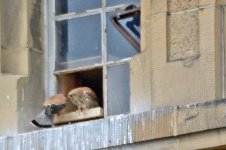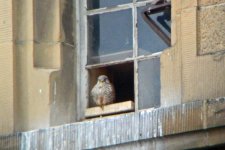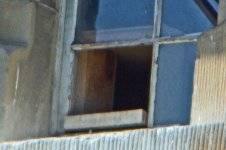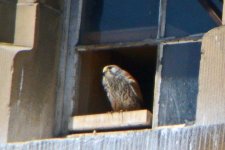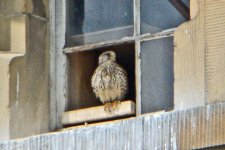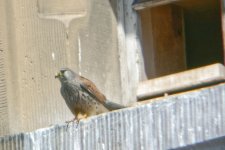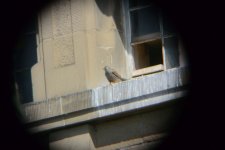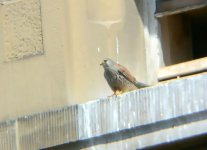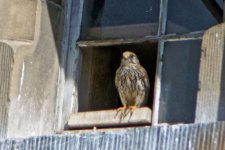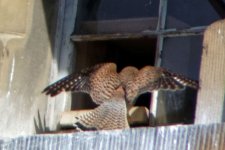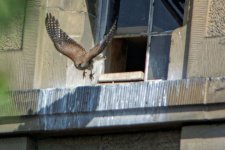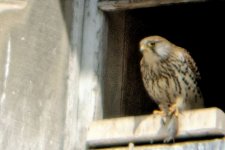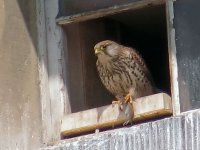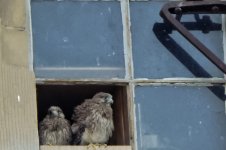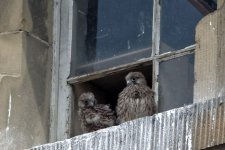-
Welcome to BirdForum, the internet's largest birding community with thousands of members from all over the world. The forums are dedicated to wild birds, birding, binoculars and equipment and all that goes with it.
Please register for an account to take part in the discussions in the forum, post your pictures in the gallery and more.
You are using an out of date browser. It may not display this or other websites correctly.
You should upgrade or use an alternative browser.
You should upgrade or use an alternative browser.
Nikon V2?? (1 Viewer)
- Thread starter curtA2
- Start date
More options
Who Replied?jourdaj
Well-known member
Hi Curt,
In case you're still interested here is a side-by-side comparison of features of the two cameras.
https://photographylife.com/nikon-1-v1-vs-v2
The biggest change is the PAMS dial on the V2 replaced the simple dial of the V1 that required submenus to put camera into PAMS modes. Otherwise slightly more megapixels (14 from 10). After talking w/ fellow digiscopers last week we all agreed that the new V3 has slightly more noise than the V1, but not significant enough to warrant a concern.
In case you're still interested here is a side-by-side comparison of features of the two cameras.
https://photographylife.com/nikon-1-v1-vs-v2
The biggest change is the PAMS dial on the V2 replaced the simple dial of the V1 that required submenus to put camera into PAMS modes. Otherwise slightly more megapixels (14 from 10). After talking w/ fellow digiscopers last week we all agreed that the new V3 has slightly more noise than the V1, but not significant enough to warrant a concern.
stevemontague
Active member
Interesting, I was curios about that at well, with the plenty of V1's being available at good prices I don't think the enhancements in the V2 & V3 would justify parting with what little money I have.
Simon Brumby
Member
I don't think the enhancements in the V2 & V3 would justify parting with what little money I have.
Wholeheartedly agree.
Jason Bugay Reyes
Well-known member

Jerry,
I noticed on long distance subject, the image quality suffer with Nikon V1. Does it the same with V3?
I noticed on long distance subject, the image quality suffer with Nikon V1. Does it the same with V3?
HermitIbis
Well-known member
I am aware that this thread is old. Still, the Nikon1 V2 remains an option, and its price keeps falling. Lately I bought a used V2 and the 10-30mm lens, mainly for "other duties", not for digiscoping. But since I own a 62mm scope, the Minox MD 62 ED (with eyepiexe 22x), the idea came to mind what my cheap gear can achieve in digiscoping. It's fair to say "cheap", because I got both camera and scope second-hand, for a total amount of less than 500 Euro. Clearly, the Minox does not have the same image quality known from 80mm+ elite scopes (Swarovski, Kowa, ...). I've read enough about digiscoping in this forum to be realistic about the capabilities of a smaller scope which weighs less than 1kg.
On the other side, it never hurts to check possibilities (and limits) of your gear. Sometimes I visit a wetland reservation, and long-distance shots from my SX50 of a rare bird, 200m away, can be quite disappointing. So I've decided to do a little test. The four photos below were all taken from a distance of 100 m, according to Google maps (103m, to be precise). All four are cropped and edited. In the case of photos 3 and 4 I could have used RAW instead of JPEG, but that would have meant more work, probably without changing much.
Photos 1 + 2: Canon SX50, at full optical zoom (1200 mm equivalent) plus some digital (144%)
Photo 3: Nikon1 V2 + 1Nikkor 70-300mm, at 300mm (810 mm equivalent).
Photo 4: Minox scope with 22x eyepiece, set up on a tripod, digiscoped with the V2 plus 10-30mm kit lens at 30mm (handheld), equivalent to 1782 mm. I chose S mode at 1/800 s, to compensate for shaky hands.
For me, none of the three configurations is a clear winner. The heavily cropped 1Nikkor 70-300mm lens is surprisingly close to the SX50 superzoom shots, and with a proper adapter (e.g. the Griturn) the scope/V2 would certainly have done better and may well be "theoretically" as good as the two rivals.
Now I wonder: would it be worth to buy the 20-45x eyepiece for the Minox scope - could the digiscoping shots improve so much that I'd always want to carry the additional weight of 1kg to the wetland reservation to get those vastly superior 200m shots?
On the other side, it never hurts to check possibilities (and limits) of your gear. Sometimes I visit a wetland reservation, and long-distance shots from my SX50 of a rare bird, 200m away, can be quite disappointing. So I've decided to do a little test. The four photos below were all taken from a distance of 100 m, according to Google maps (103m, to be precise). All four are cropped and edited. In the case of photos 3 and 4 I could have used RAW instead of JPEG, but that would have meant more work, probably without changing much.
Photos 1 + 2: Canon SX50, at full optical zoom (1200 mm equivalent) plus some digital (144%)
Photo 3: Nikon1 V2 + 1Nikkor 70-300mm, at 300mm (810 mm equivalent).
Photo 4: Minox scope with 22x eyepiece, set up on a tripod, digiscoped with the V2 plus 10-30mm kit lens at 30mm (handheld), equivalent to 1782 mm. I chose S mode at 1/800 s, to compensate for shaky hands.
For me, none of the three configurations is a clear winner. The heavily cropped 1Nikkor 70-300mm lens is surprisingly close to the SX50 superzoom shots, and with a proper adapter (e.g. the Griturn) the scope/V2 would certainly have done better and may well be "theoretically" as good as the two rivals.
Now I wonder: would it be worth to buy the 20-45x eyepiece for the Minox scope - could the digiscoping shots improve so much that I'd always want to carry the additional weight of 1kg to the wetland reservation to get those vastly superior 200m shots?
Attachments
Last edited:
HermitIbis
Well-known member
I suspect a major weakness of my digiscoping set-up are my bad eyes, I find it hard to focus the scope accurately. The V2 and the 10-30mm lens are doing a fine job, and according to the various V1 digiscoping threads the 18.5mm lens (used ~90 Euro) or the 11-27.5mm zoom (used ~70 Euro) are even better.
Varying my camera settings (following advice in V1 threads - matrix metering and AF-S rather than AF-C) and focusing manually with the screen (instead of the EVF) has produced a somewhat better picture (see below) in my standard 100m-distance test scenario. Sorry, the birds had apparently taken a day off.
I've ordered a Baader Microstage II adapter, which may improve the results. It's still unlikely that I'll purchase a 30x WW (with 19.5mm eye-relief probably the better choice) or 20-45x eyepiece (ER only 16-17mm). Even if I could improve the digiscoping gear to an extent that it consistently beats the first picture in the last post, there is room für optimization with the SX50, too: put it on a tripod, use a remote shutter control device with interval shooting...
Of course, the big advantage of the V2 is that you can shoot bursts of 7-40 shots of JPEG (fine) or even RAW at 15-60 fps in interesting situations. The SX50 in Auto + digital zoom offers only single-shot.
Varying my camera settings (following advice in V1 threads - matrix metering and AF-S rather than AF-C) and focusing manually with the screen (instead of the EVF) has produced a somewhat better picture (see below) in my standard 100m-distance test scenario. Sorry, the birds had apparently taken a day off.
I've ordered a Baader Microstage II adapter, which may improve the results. It's still unlikely that I'll purchase a 30x WW (with 19.5mm eye-relief probably the better choice) or 20-45x eyepiece (ER only 16-17mm). Even if I could improve the digiscoping gear to an extent that it consistently beats the first picture in the last post, there is room für optimization with the SX50, too: put it on a tripod, use a remote shutter control device with interval shooting...
Of course, the big advantage of the V2 is that you can shoot bursts of 7-40 shots of JPEG (fine) or even RAW at 15-60 fps in interesting situations. The SX50 in Auto + digital zoom offers only single-shot.
Attachments
Last edited:
HermitIbis
Well-known member
The Baader adapter is useful, as I no longer fear to scratch the lens or the eyepiece. And I can get more photos. A new photo below, a little closer to "superzoom quality". This more or less proves for me that my scope + the V2 might beat the SX50, with the right combination of a good lens and maybe the 20-45x eyepiece.
Postscript. I am aware that many of the best pictures in the digiscoping section were shot at a magnification of ~30x, using the V1 with the top-notch 18.5mm lens. However, in a case like mine, where obviously my bad eyes are the main source of failure (when focusing the scope), shouldn't it be my guiding line to "see the bird as large as possible on the screen", to give me a better chance to (a) focus the scope, and (b) focus with the camera on the bird, either manually or AF? And following this logic, wouldn't the 20-45x eyepiece combined with the 11-27.5mm lens be my best option (rather than combining the 30x WW eyepiece with the 18.5mm 1Nikkor lens)?
Postscript. I am aware that many of the best pictures in the digiscoping section were shot at a magnification of ~30x, using the V1 with the top-notch 18.5mm lens. However, in a case like mine, where obviously my bad eyes are the main source of failure (when focusing the scope), shouldn't it be my guiding line to "see the bird as large as possible on the screen", to give me a better chance to (a) focus the scope, and (b) focus with the camera on the bird, either manually or AF? And following this logic, wouldn't the 20-45x eyepiece combined with the 11-27.5mm lens be my best option (rather than combining the 30x WW eyepiece with the 18.5mm 1Nikkor lens)?
Attachments
Last edited:
HermitIbis
Well-known member
A new attempt to digiscope kestrels 103 m away with my Minox MD 62 ED scope and the Nikon V2. The difference is that I used a new lens, the 1Nikkor 18.5mm. A bit surprising that the quality and sharpness of this lens seems to matter more than the 30mm focal length of the kit lens - now the eyes of the bird are visible.
Attachments
HermitIbis
Well-known member
Kestrel digiscoped today with my Minox scope and the 20-45x zoom eyepiece at 45x magnification, using the Nikon V2 and the 18.5mm lens. The raw file edited with DxO Optics Pro 10 and Photoshop Elements.
This 20-45x zoom eyepiece has a non-adjustable (and non-removable) eyecup, so that the camera doesn't get close to the eyepiece and the picture shows strong vignetting (see second photo). The 30x eyepiece doesn't suffer from vignetting with the V2, it has an adjustable eyecup and a wide view.
Maybe my experiences are useful for others who own a similar midsize scope.
This 20-45x zoom eyepiece has a non-adjustable (and non-removable) eyecup, so that the camera doesn't get close to the eyepiece and the picture shows strong vignetting (see second photo). The 30x eyepiece doesn't suffer from vignetting with the V2, it has an adjustable eyecup and a wide view.
Maybe my experiences are useful for others who own a similar midsize scope.
Attachments
Kestrel digiscoped today with my Minox scope and the 20-45x zoom eyepiece at 45x magnification, using the Nikon V2 and the 18.5mm lens. The raw file edited with DxO Optics Pro 10 and Photoshop Elements.
This 20-45x zoom eyepiece has a non-adjustable (and non-removable) eyecup, so that the camera doesn't get close to the eyepiece and the picture shows strong vignetting (see second photo). The 30x eyepiece doesn't suffer from vignetting with the V2, it has an adjustable eyecup and a wide view.
Maybe my experiences are useful for others who own a similar midsize scope.
You're reminding me of the fun of playing around with different camera/scope/lens combo in the early days of digiscoping.
I had a look at your exif info and had a quick play with the vignetted photo in Photoshop. If you Unsharp Mask the image aggressively it shows that there is some sharpness there (see attached). The time of day and the distance is not helping the detail. Digiscoping is best done in the first and last 3 hours of the day when the sun's angle is lower in the sky. Also try Aperture Priority as the lens should be wide open (f1.7) to minimise vignetting. Also drop the iso down to 400 to reduce noise. It is hard to beat a 30x eyepiece for digiscoping.
If you have time could you drop me a full sized Raw image at [email protected] to play with.
Hope this helps,
Neil.
Attachments
HermitIbis
Well-known member
You're reminding me of the fun of playing around with different camera/scope/lens combo in the early days of digiscoping.
I had a look at your exif info and had a quick play with the vignetted photo in Photoshop. If you Unsharp Mask the image aggressively it shows that there is some sharpness there (see attached). The time of day and the distance is not helping the detail. Digiscoping is best done in the first and last 3 hours of the day when the sun's angle is lower in the sky. Also try Aperture Priority as the lens should be wide open (f1.7) to minimise vignetting. Also drop the iso down to 400 to reduce noise. It is hard to beat a 30x eyepiece for digiscoping.
If you have time could you drop me a full sized Raw image at [email protected] to play with.
Hope this helps,
Neil.
Many thanks, Neil, for your advice - very helpful indeed. Your suggested camera settings make a lot of sense, as I've already seen today in a short test. Unfortunately, the window with the Kestrels is in the shadow for much of the day, the sun will reach their window only at 10:30 a.m., and the birds are not so active in the evening.
I've just e-mailed to your address with the raw file attached.
Just as you say: it's fun to experiment with my options. My need for finding a long-distance solution isn't urgent, since I visit this wetland only about once per month. Still, it would be nice to get better photos of wading birds.
Best, Stefan
(alias HermitIbis)
HermitIbis
Well-known member
Three photos from yesterday with the 30x ww eyepiece. The first is probably my best (= sharpest) so far with this eyepiece, its exif data (1/1000 sec., f/1.8, iso=160) are exactly what you are hoping for (thanks again, Neil!). All photos were taken in RAW, edited with DxO Optics Pro 10 and PS Elements 9.
Attachments
Last edited:
HermitIbis
Well-known member
Time for some conclusions. The first photo shows what I can achieve with my 62mm scope at a distance of 100m - the Kestrel has caught a mouse! The second photo was taken at the same moment with a Canon SX50. For this comparison shooting I had set up the bridge camera on a ballhead, mounted on a hide clamp fixed at a table. For both cameras, the V2 and the SX50, the shutter was activated via remote control. - Digiscoping can yield great results with 80+ mm scopes handled by people with good eyesight, but I believe I should rather rely on cameras and their autofocus systems.
Eventually I hope to get a better scope. It isn't urgent though, as the waders are not my present priority.
The third photo in reply #7 taken with the Nikon V2 and the CX 70-300 lens had been heavily cropped. Still, I wondered: shouldn't this expensive lens be sharper even at a 100m distance? As I see it, there are two possible explanations: (a) the lens struggles to focus on far-away objects, or (b) the focusing rectangle of the V2 wasn't able to focus sharply on the birds, because it hit the facade of the building (the window is in a recess). So I took photos 3 (from about 80 meters) and 4 (from about 65 meters), when the CX 70-300 did well enough.
Eventually I hope to get a better scope. It isn't urgent though, as the waders are not my present priority.
The third photo in reply #7 taken with the Nikon V2 and the CX 70-300 lens had been heavily cropped. Still, I wondered: shouldn't this expensive lens be sharper even at a 100m distance? As I see it, there are two possible explanations: (a) the lens struggles to focus on far-away objects, or (b) the focusing rectangle of the V2 wasn't able to focus sharply on the birds, because it hit the facade of the building (the window is in a recess). So I took photos 3 (from about 80 meters) and 4 (from about 65 meters), when the CX 70-300 did well enough.
Attachments
Similar threads
- Replies
- 2
- Views
- 696
Users who are viewing this thread
Total: 2 (members: 0, guests: 2)




